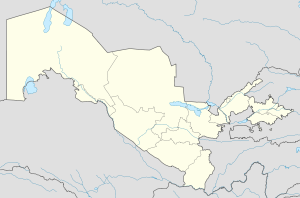Bukhara
| Bukhara Buxoro / Бухоро |
|
|---|---|
 |
|
 Bukhara
|
|
| Coordinates: | |
| Country | |
| Province | Bukhara Province |
| Government | |
| - Hokim | Rustamov Qiyomiddin Qahhorovich |
| Population (2009) | |
| - City | 263,400 |
| - Urban | 283,400 |
| - Metro | 328,400 |
| Time zone | GMT +5 |
| Postcode | 2001ХХ |
| Area code(s) | local 365, int. +99865 |
| Website | http://www.buxoro.uz/ |
Bukhara (Uzbek: Buxoro / Бухоро; Tajik: Бухоро; Persian: بُخارا; Russian: Бухара), from the Soghdian βuxārak ("lucky place"), is the capital of the Bukhara Province (viloyat) of Uzbekistan. The nation's fifth-largest city, it has a population of 263,400 (2009 census estimate). The region around Bukhara has been inhabited for at least five millennia and the city itself has existed for half that time. Located on the Silk Road, the city has long been a center of trade, scholarship, culture, and religion. The historic center of Bukhara, which contains numerous mosques and madrassas, has been listed by UNESCO as one of the World Heritage Sites. Ethnic Tajiks constitute the majority in Bukhara.
Contents |
Names
Bukhara is populated with mainly Tajik-speakers. Among its minorities are Russian, Uzbeks, Armenians, etc. Bukhara was also known as Bokhara in 19th and early 20th century English publications and as Buhe/Puhe(捕喝) in Tang Chinese.[1]
Indo-Iranian Soghdians inhabited the area and some centuries later the Persian language became dominant among them. Encyclopædia Iranica mentions that the name Bukhara is possibly derived from the Soghdian βuxārak ("Place of Good Fortune").[2] Another possible source of the name Bukhara may be an evolution of the Sanskrit word "Vihara" (monastery), and may be linked to the predominance of Buddhism before the rise of Islam in the 8th century AD.[3]
Muhammad ibn Jafar Narshakhi in his History of Bukhara (completed 943-44 CE) mentions:
Bukhara has many names. One of its name was Numijkat. It has also been called "Bumiskat". It has 2 names in Arabic. One is "Madinat al Sufriya" meaning - "the copper city" and another is "Madinat Al Tujjar" meaning - "The city of Merchants". But, the name Bukhara is more known than all the other names. In Khorasan, there is no other city with so many names[4]
History
Major sights
Fitzroy Maclean, then a young diplomat in the British Embassy in Moscow, made a surreptitious visit to Bokhara in 1938, sight-seeing and sleeping in parks. In his memoir Eastern Approaches, he judged it an "enchanted city", with buildings that rivalled "the finest architecture of the Italian Renaissance".
Po-i-Kalan complex

The title Po-i Kalan (also Poi Kalân, Persian پای کلان meaning the "Grand Foundation"), belongs to the architectural complex located at the base of the great minaret Kalân.
- Kalyan minaret. More properly, Minâra-i Kalân, (Pesian/Tajik for the "Grand Minaret"). It is made in the form of a circular-pillar brick tower, narrowing upwards, of 9 meters (29.53 ft) diameter at the bottom, 6 meters (19.69 ft) overhead and 45.6 meters (149.61 ft) high. Also known as the Tower of Death, as for centuries criminals were executed by being tossed off the top.
- Kalân Mosque (Masjid-i Kalân), arguably completed in 1514, is equal to the Bibi-Khanym Mosque in Samarkand in size. Although they are of the same type of building, they are absolutely different in terms of art of building.
- Mir-i Arab Madrassah. There is little known about its origin, although its construction is ascribed to Sheikh Abdullah Yamani of Yemen, the spiritual mentor of early Shaybanids. He was in charge of donations of Ubaidollah Khan (gov. 1533-1539), devoted to construction of madrasah.
Ismail Samani mausoleum
The Ismail Samani mausoleum (9th-10th century), one of the most esteemed sights of Central Asian architecture, was built in the 9th century (between 892 and 943) as the resting-place of Ismail Samani - the founder of the Samanid dynasty, the last Persian dynasty to rule in Central Asia, which held the city in the 9th and 10th centuries. Although in the first instance the Samanids were Governors of Khorasan and Ma wara'u'n-nahr under the suzerainty of the Abbasid Caliphate, the dynasty soon established virtual independence from Baghdad.
Chashma-Ayub mausoleum
Chashma-Ayub is located near the Samani mausoleum. Its name in Persian means Job's spring due to the legend according to which Job (Ayub) visited this place and brought forth a spring of water by the blow of his staff on the ground. The water of this well is still pure and is considered healing. The current building was constructed during the reign of Timur and features a Khwarazm-style conical dome uncommon in Bukhara.
Lab-i Hauz
The Lab-i Hauz (or Lab-e hauz, Persian: لب حوض, meaning by the pond) Ensemble (1568–1622) is the name of the area surrounding one of the few remaining hauz (ponds) in the city of Bukhara. Until the Soviet period there were many such ponds, which were the city's principal source of water, but they were notorious for spreading disease and were mostly filled in during the 1920s and 1930s. The Lyab-i Hauz survived because it is the centrepiece of a magnificent architectural ensemble, created during the 16th and 17th centuries, which has not been significantly changed since. The Lyab-i Hauz ensemble, surrounding the pond on three sides, consists of the Kukeldash Madrasah[5] (1568–1569), the largest in the city (on the north side of the pont), and of two religious edifices built by Nadir Divan-Beghi: a khanaka[6] (1620), or lodging-house for itinerant Sufis, and a madrasah[7] (1622) that stand on the west and east sides of the pond respectively.
Transportation
- Bukhara Airport
The M37 highway connects the city to most of the major cities in Turkmenistan including Ashgabat.
Demographics
Bukhara (along with Samarkand) is one of the two major centres of Uzbekistan's Tajik majority. Bukhara was also home to the Bukharian Jews, whose ancestors settled in the city during Roman times. Most Bukharian Jews left Bukhara between 1925 and 2000.
Poetry and literature
Being a cultural magnet, Bukhara has long appeared in much local and Persian literature. Many examples can be sought.
ای بخارا شاد باش و دیر زی
Oh Bukhara! Be joyous and live long!
شاه زی تو میهمان آید همی
Your King comes to you in ceremony.
---Rudaki
Dehkhoda defines the name Bukhara itself as meaning "full of knowledge", referring to the fact that in antiquity, Bukhara was a scientific and scholarship powerhouse. Rumi verifies this when he praises the city as such:
آن بخارا معدن دانش بود
"Bukhara was a mine of knowledge,
پس بخاراییست هرک آنش بود
Of Bukhara is he who possesses knowledge."
In the Italian romantic epic Orlando innamorato by Matteo Maria Boiardo, Bukhara is called Albracca and described as a major city of Cathay. There, within its walled city and fortress, Angelica and the knights she has befriended make their stand when attacked by Agrican, emperor of Tartary. As described, this siege by Agrican resembles the historic siege by Genghis Khan in 1220.[8]
Notable people
Many prominent people lived in Bukhara in the past. Most famous of them are:
- Muhammad Ibn Ismail Ibn Ibrahim Ibn al-Mughirah Ibn Bardizbah al-Bukhari (810-870) - Islamic scholar and compiler of hadiths
- Avicenna (Abu Ali ibn Sina) (980-1037) - physician and person of encyclopedic knowledge
- Bal'ami: Abolfazl Muhammad and his son Abu-Ali Mohammad, two famous viziers of Samanid kings, historians and patrons of art and literature
- Abubakr Narshakhi (10th century) - historian who wrote History of Bukhara
- Utabi (11th century)
- Ismatallah Bukhari (1365–1426) - known as Khawjeh Ismat, poet during Timurids.
- Molana Abd-al-Hakim (16th century) - physician
- Mirza Abd al-Aziz Bukhari (the end the 18th century - the beginning of the 19th century) - the calligrapher.
- Rahmat-Allah Bukhari (died in 1893) - the specialist in study of literature
- Baha-ud-Din Naqshband Bukhari
- Zamakhshari
- Muhammad al-Bukhari
- Usman Bukhari
- Kiromi Bukhoroi
- An Lushan
- Oksana Chusovitina
- Hazrat Syed Jalaluddin Surkh-Posh Bukhari
Education
- Several universities and institutions of higher learning:
Sister cities
 Lahore, Pakistan
Lahore, Pakistan Santa Fe, New Mexico, USA
Santa Fe, New Mexico, USA Rueil-Malmaison, France
Rueil-Malmaison, France Córdoba, Spain
Córdoba, Spain Malatya, Turkey
Malatya, Turkey
See also
- Bukhara rug
References
- ↑ "UMID" Foundation, Uzbekistan. "General Info". http://www.umid.uz/Main/Uzbekistan/General_Info/general_info.html. Retrieved 2007-10-04.
- ↑ Richard N Frye, 'Bukhara i. In pre-Islamic times', Encyclopædia Iranica, 512.
- ↑ Gregoire Frumkin, Archaeology in Soviet Central Asia, Brill, Leiden, 1970.
- ↑ Narshaki,Richard Nelson Fyre, The History of Bukhara, Pg 27
- ↑ Dmitriy Page, Pagetour.narod.ru. "Kukeldash Madrasah". http://www.pagetour.narod.ru/bukhara/bu/Kukeldash.htm. Retrieved 2007-10-04.
- ↑ Dmitriy Page, Pagetour.narod.ru. "Nadir Divan-Begi Khanaka". http://www.pagetour.narod.ru/bukhara/bu/Khanaka.htm. Retrieved 2007-10-04.
- ↑ Dmitriy Page, Pagetour.narod.ru. "Nadir Divan-Begi Madrasah". http://www.pagetour.narod.ru/bukhara/bu/Nadir_Divan_Begi.htm. Retrieved 2007-10-04.
- ↑ Boiardo: Orlando innamorato, verse translation by Charles Stanley Ross (Oxford University Press, 1995), Book I, Cantos 10-19 and Explanatory Notes, pp. 401-402. ISBN 0-19-282438-4
Further reading
- Moorcroft, William and Trebeck, George. 1841. Travels in the Himalayan Provinces of Hindustan and the Panjab; in Ladakh and Kashmir, in Peshawar, Kabul, Kunduz, and Bokhara... from 1819 to 1825, Vol. II. Reprint: New Delhi, Sagar Publications, 1971.
External links
|
||||||||||||||||
|
|||||||||||
|
||||||||
